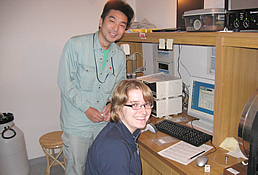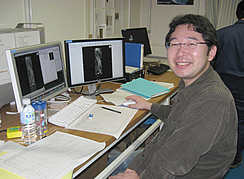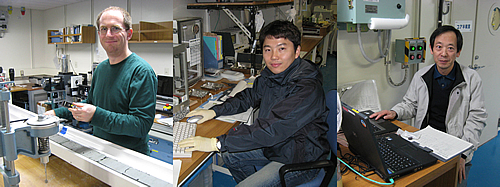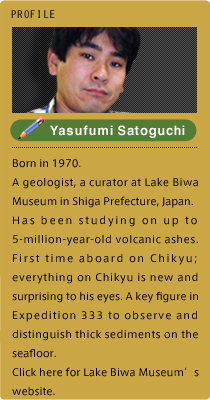

“Let’s interview!”2010.12.31
Hello. The ship is rolling. I am looking into the microscope and feeling kind of “hmm…” Chikyu does not roll much. But in the past few days the waves have been rough and the cruise has been quite rocky. The microscope work on a rolling and tossing ship is uneasy; as it rolls and tosses, the object under microscope gets out of focus. I mean, this is my first experience to feel this way, burp… Ya, I feel I am having seasick!
I think I have said enough about my own research in my past reports, so today I would like to share what I learnt through the interviews I have done with the scientists on board. They are from the geosciences fields like myself but are specialised in individual category, so there are plenty of new things for me to learn.
So, here is what they passionately told me when I asked them my question “what are you doing and studying in general?”
The first answer was... “As Palaeomagnetic Group, we are measuring the directions of geomagnetism of long ago.”

Night shift members of Palaeomagnetic Group. Kiichiro (left) and Beth (right). Beth is very friendly and Kiichiro does his work at his own pace.
Geomagnetism is a magnetic force that lets the compass indicate N or S to show which direction is north and south on the Earth. Today, the “N” on the compass indicates north, but in a very long term this has not stayed as the way it is now. In a large-scale planetary history, there are times when the “S” on the compass showed north, and it can repeat back and forth according to the palaeomagnetic conditions. And the times when these magnetic fields changed their directions have been studied by numerous scientists already. Now, do you have a brief idea what palaeomagnetists are trying to find out? The directions of geomagnetism are preserved within the sediments, thus by comparing the data collected in the past and the sediments being cored in this expedition let the palaeomagnetists establish the time when these layers were formed.
To put it simply, palaeomagnetists are measuring the geomagnetism in order to study different times of the Earth’s history when the layers were formed.
Next... I see someone working over there. Let’s ask him! He is from the “Structure Group”.
“I’m looking into the structures of the obtained boring cores.”
“Hmm... Could you tell me a little more specifically?”
“The cores have the layer’s deformation and fault information. These structure conditions are my research target.”
Then I asked him what has been interesting in this expedition so far, and he told me that the similarity in between deformed structures in the obtained cores and the terrestrial strata was quite significant and interesting.
The deformation within strata may appear in numerous versions. Some strata are physically cut due to some conditions, which are called “fault” or “dislocation”. Some get deformed when drained, while some change their directions of layers due to pressures. There are even signs of altered strata that may have been affected by biological effects!
The Structure Group also uses the CT scanner to identify deformations within the cores. CT scanner reminds us of the ones for medical use. Here on Chikyu, it is used to check what are contained in the sampled cores without physically damaging or destroying them. What is more special is that only Chikyu has CT scanner onboard among other drilling vessels. Isn’t it great!?

Asuka, a night-shifter of Structure Group. This group has only two scientists in charge so both night-shifter and day-shifter are busy! Asuka looks excited when he is looking at CT images.
Now, let’s talk to the members of the Physical Properties Group.
“Hi, how are you? What are you doing?”
They told me about different responsibilities each member holds. Hugh is measuring the physical strength of the strata, which is to check how much pressures the strata can hold.

Night-shifters of Physical Properties Group. Hugh (left), Gwansoo (centre), and Osamu (right), doing different works. Hugh has a nice smile, Gwangsoo is stylish, and Osamu is calm...
Gwangsoo is mainly checking the weight of sediments and the water contained in them. By doing so, he can identify how tightly the particles are forming the sediments. This data is useful for finding out how the seismic waves travel below the seafloor and underground. He talked to me with his passion for his research! However, my understanding of his speciality was limited, so I need to stop here. I apologize for that.
I see Osamu observing the core’s temperature. Let’s ask him what he is trying to study. From what Osamu told me, the relationship between the depth of the strata and the temperature differ from place to place according to how the temperature travels, as the Earth’s centre is hotter and the outer layer cooler. By studying these differences, he can discover what is happening under the seafloor, and how heat affects the strata and the rocks. I see, Osamu is studying the heat, and he talked to me with his “heat” in his heart!
I can not introduce all the scientists at once (or I can not understand them all at once!) so I will continue with the interview and report it next time. Hopefully, see you soon!
Yasufumi Satoguchi


















